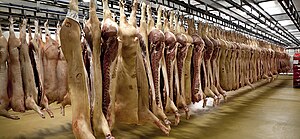
Back صناعة اللحوم Arabic Indústria càrnia Catalan Fleischwirtschaft German Industria cárnica Spanish Harakintza Basque صنعت گوشت Persian Industrie de la viande French תעשיית הבשר HE मांस उद्योग Hindi Húsipar Hungarian
The meat industry are the people and companies engaged in modern industrialized livestock agriculture for the production, packing, preservation and marketing of meat (in contrast to dairy products, wool, etc.). In economics, the meat industry is a fusion of primary (agriculture) and secondary (industry) activity and hard to characterize strictly in terms of either one alone. The greater part of the meat industry is the meat packing industry – the segment that handles the slaughtering, processing, packaging, and distribution of animals such as poultry, cattle, pigs, sheep and other livestock.

A great portion of the ever-growing[1] meat branch in the food industry involves intensive animal farming in which livestock are kept almost entirely indoors[2] or in restricted outdoor settings like pens. Many aspects of the raising of animals for meat have become industrialized, even many practices more associated with smaller family farms, e.g. gourmet foods such as foie gras.[3][4] The production of livestock is a heavily vertically integrated industry where the majority of supply chain stages are integrated and owned by one company.[citation needed]
- ^ "Global Meat Production and Consumption Continue to Rise". Worldwatch Institute. Archived from the original on 24 January 2013. Retrieved 30 June 2015.
- ^ Paul Ebner. "Modern Livestock Facilities". Purdue University. Archived from the original on 22 May 2018. Retrieved 1 March 2016.
- ^ "Foie Gras: Cruelty to Ducks and Geese | Ducks and Geese Used for Food | Factory Farming: Misery for Animals | The Issues". PETA. 21 June 2010. Retrieved 16 January 2017.
- ^ "An Animal Equality investigation". Foie Gras farms. Retrieved 16 January 2017.